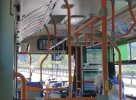A bit out of context - all the bus stops on a particular route served by dual door buses need to be suitable and safe.
Not correct. It is possible, with on-board announcements, not to use the rear door at selected stops where it isn't feasible or cost-effective to make them safe, e.g. sawtooth bus stations.
The key is that you do spend the money to ensure that
at any stop where there is typically both boarding and alighting, the dual doors can be used, because that's where the benefit is gained (there isn't any benefit at any stop where in any given direction you only get boarding OR alighting, not both). But in reality most stops are a pole by the side of the road so it can be used anyway.
Yes, you'd have to drive the route and do a risk assessment of each stop but that's not hard, particularly given that most bus stops are just a pole by the side of the road.
And no you don't need all routes to have dual door. People have eyes and can see if there's a second door or not, and can read a sign saying EXIT. And if the odd person doesn't, they get off at the front, the world has not ended.
Perfection is the enemy of the good. It's a bit like saying contactless tap-in tap-out has no value because some people prefer cash. It does, because most people now pay card (or pass), which mean the small number of remaining people who do pay cash don't have a significant impact on things (which has long been the German and Dutch approach, in the latter case pre-OV Chipkaart - mostly off-bus ticketing, but one or two cash payers make little difference).

 - except for people with prams or pushchairs; at least in Helsinki you can use any door.
- except for people with prams or pushchairs; at least in Helsinki you can use any door.